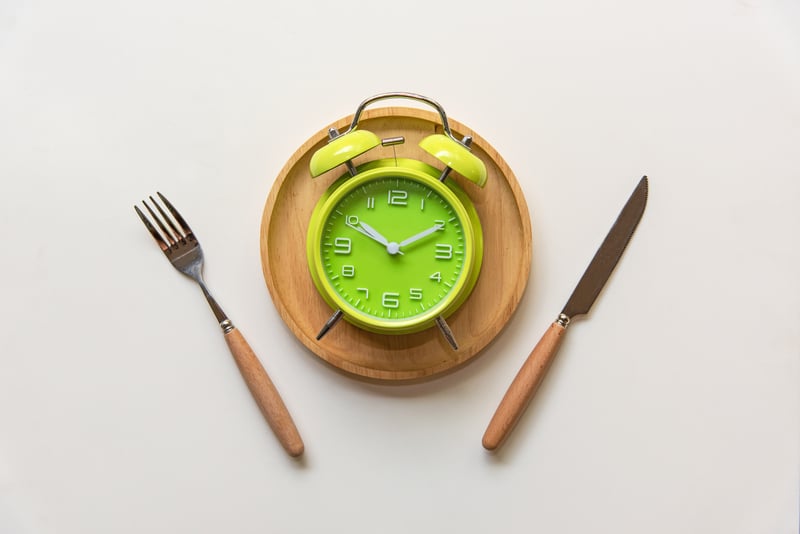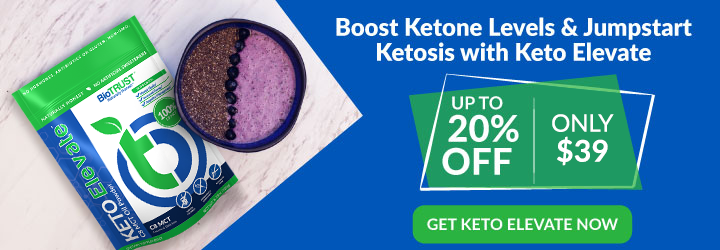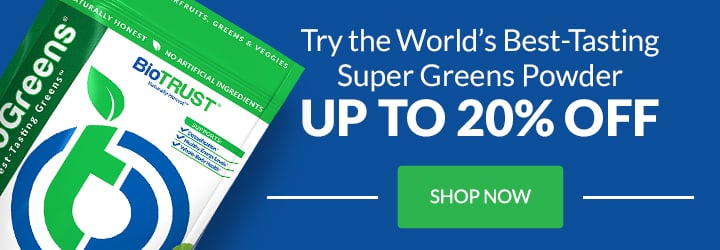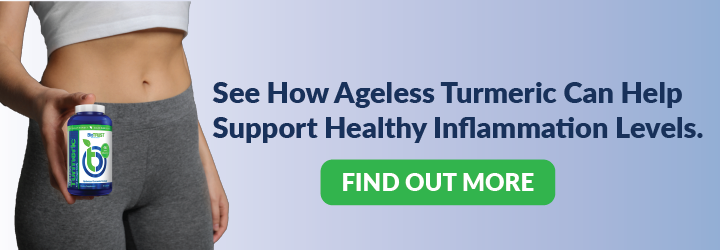How to Detox and Refresh Your Body’s Cells with Autophagy

If you’re like a lot of folks, you’ve tried detoxing, juice cleanses, and more in an effort to lose weight, boost health, or both: To look and feel better. But did you know that your body already has a way of cleansing itself—no detox program needed? It’s known as autophagy (pronounced ah*TAH*fuh*gee), and it’s the process the body uses to literally “eat itself.” (The word “autophagy” actually translates to “self-eating” in Greek.) 1
In today’s article about autophagy, we will cover:
- What is Autophagy?
- Benefits of Autophagy
- How to Induce Autophagy
- Foods That Promote Autophagy
- Signs of Autophagy
What is Autophagy?
Self-cannibalism sounds pretty extreme, yet it’s a natural process that is good—even essential—for the health of the body. You can think of autophagy as the body’s way of clearing out debris, separating the recycling, and dumping the trash. The body uses this process to clean house, remove diseased or just plain used-up, tired, and dead cells, and then reuse the good parts to rebuild stronger, healthier cells. It’s been described as the body’s own “recycling” and “fueling” program that provides sources of energy or building blocks for the creation of macronutrients.
Although autophagy was discovered back in the 1960s, it’s only recently getting the attention it deserves. It came into the spotlight thanks to the Japanese scientist Yoshinori Ohsumi, who began studying autophagy in the 1990s, winning the Nobel Prize in 2016 for his research into the mechanisms of autophagy and how it better helps us understand diseases like dementia and Parkinson’s.
Benefits of Autophagy
Autophagy is used by the body after infections to destroy bacteria and viruses. It’s been found to help counteract the negative effects caused by aging by ridding the body of old, worn-out proteins and organelles.
In other words, the autophagy process helps our bodies fight off aging, infections, and excess inflammation, and it helps protect against diseases, including Parkinson’s, Huntington’s, forms of dementia, and others. It’s the body’s way of recycling proteins to provide energy for cells to repair and rebuild, and it promotes regeneration for healthy cells. It’s even been found to be helpful as a therapeutic for alcohol and drug-induced liver injury. 2 – 4
Understandably, academics and drug companies, as well as diet and wellness experts, were soon jumping onto the research bandwagon to discover how to stimulate or optimize the natural process to help people enjoy greater health. Naturally, a timeless question appeared time and again: Could autophagy be the fountain of youth?
The research on autophagy is currently in its infancy, and while there is a large, growing body of evidence, the majority of it is currently based on test tube and animal studies. For example, in 2012, researchers found that exercise-induced autophagy protected against aging, cancer, infections, inflammatory disease, insulin resistance, and neurodegenerative disorders in mice. 5 Other rodent studies have found that autophagy is needed to optimize anticancer surveillance by the immune system. 6 – 8
Additional research has shown that when an essential autophagy gene (Atg7) was removed from mice, the mice had higher body weights and fat, were lethargic, had higher cholesterol, and experienced glucose intolerance, and their brain function was impaired. This led researchers to conclude that the process of autophagy was necessary for normal metabolic regulation and neural development. 9
The reason many people are so interested in autophagy is because of numerous possible benefits, including: 10
- Improved heart health
- Increased metabolism and energy
- Maintenance of muscle mass 11
- Protection from neurodegenerative mental diseases 12
- Antiviral and antibacterial properties 13
- Management of inflammation
- Support for fighting off infection and for balanced immunity 14
- And, of course, anti-aging 15
How to Induce Autophagy
In the simplest terms, autophagy is a natural response to stress. So, if you want to induce autophagy, research indicates you will want to put your body under greater stress or discomfort than usual. Here are six potential methods:
1. Induce ketosis
Perhaps the best way to do so is to follow a ketogenic diet by dropping your carb consumption to less than 5% of your calories (roughly 20 – 30 grams of carbohydrate per day) and increasing fat to about 75% of your daily calories so your body has no choice but to live off fat for energy. As a result, your body will produce ketone bodies, which may have protective benefits. That is, it can cause stress that turns the body toward repair for survival (i.e., autophagy).
As a bonus, many people who follow a ketogenic diet find they lose fat, retain muscle, control blood sugar, clear up skin, decrease disease risk, and experience clearer thinking. 16 Keto diets have also been shown to be neuroprotective in some research. 17 Curious? Learn how to start a keto diet.
2. Cut carbs
If the full keto diet sounds too challenging, just cutting carbs down to less than 30% of overall calories is another path to autophagy, according to a 2012 study. 18 A high-protein, low-carb diet is very popular, as it’s often easier for people to follow and also provides additional benefits. Learn more here.
3. Fasting
Let’s face it: skipping meals can be stressful, and many people resist the idea. But the short-term discomfort may lead to long-term gains, even with occasional fasting. 19 – 21 Benefits of fasting, specifically intermittent fasting, can include weight loss, improved insulin sensitivity, reduced oxidative stress, improved cognition, delayed aging, and increased lifespan. 22 Restricting food intake to modulate autophagy has even been found in research to help enhance anti-cancer therapies while protecting healthy cells. 23
There are different types of intermittent fasting, and some variations may be easier for you to follow than others.
4. Protein cycling
Many people have heard of carb cycling, but you can also cycle your protein intake or fast (for short periods of time) from protein altogether. Proponents of the practice suggest it can help “reduce inflammation and kickstart fat loss” primarily by triggering autophagy. The idea is that when protein isn’t sufficient in the diet, the body turns to ways to recycle proteins. Considering that about 15% of your body weight is comprised of proteins, the body has a pretty decent repository, taking apart proteins that are past their prime, doing a deep clean, and then rebuilding to create younger, stronger proteins with the parts. The benefits, then, are similar to fasting. In fact, this is at least part of the rationale behind the fasting-mimicking diet (FMD).
As with fasting, the protein deficit (dropping down to a mere 15 to 25 grams per day, or in the case of FMD, about 10% of normal intake) should only be temporary—usually no more than 24 to 48 hours for highly-restrictive protein cycling or about 5 days for FMD. Low-protein diet days can look a lot like going vegan—relying on plenty of lower-protein vegetables. As a bonus, if you do this once per week, as is typically recommended by proponents, it can also have a positive environmental impact.
5. Exercise regularly
Another common (and invited) form of stress is exercise—especially exercise that makes you sweat, grunt, and feel sore the next day. 24 The microscopic tears that damage muscles indicate your body is sending in resources to help the muscles repair and grow stronger and more resistant to future insults. It’s one of the most popular ways that people unknowingly or unintentionally induce autophagy and help cleanse and detox the body. 25,26 It’s not yet known how much exercise is needed to induce autophagy, but since exercise has so many benefits, it’s a great idea to ensure you’re getting in at least 75 to 150 minutes per week (15 to 30 minutes per day).
Researchers wonder if autophagy may be one reason exercise is so good for the brain and improved cognitive function. 27
6. Get a good sweat
Hopping into a sauna with the temperature set between 120- and 180-degrees F° can activate autophagy-inducing heat-shock proteins, stimulate the lymphatic system, boost circulation, and help trigger autophagy. 28
Going from cold to hot (or hot to cold) can also lead to a stress response that can trigger autophagy. 29 For example, going outside in the winter with minimal clothing and then jumping into a hot shower may be one way to induce the process. Or, simply go from hot to cold to hot again within the same shower—a therapeutic strategy known as a “contrast shower”—to trigger the effect.
While there’s still a lot to learn about autophagy, researchers and experts, at this point, say you don’t need to stay in ketosis all of the time, fast daily, or even exercise intensely every day to enjoy benefits. A few hours weekly of one or more of the above stressors appears to help the body naturally induce autophagy.
Another important component for optimizing autophagy is to do whatever you need to get a good night’s sleep, as this is when the body naturally goes into repair mode. To support your body’s natural autophagy processes, get at least seven hours of quality, uninterrupted sleep every night, maintain your circadian rhythm, and promote the production and release of melatonin at night by avoiding blue light and getting sunlight within the first hour of waking when possible. 30-35
Foods That Promote Autophagy
We’ve discussed how you eat, but what about what you eat? Can that affect autophagy? Perhaps. Some foods that may help trigger the process (at least according to animal research) include:
Curcumin, which is found in the worldwide popular spice turmeric, has been shown in at least a couple of small animal studies to induce autophagy. This may be one reason why curcumin may help protect the heart muscles in those with diabetes as well as helping fight cognitive impairment. 35-40 However, these studies are preliminary, and much more research needs to be completed before we have a better understanding of curcumin’s potential effects on autophagy.
Herbs like Ceylon cinnamon, ginger, ginseng, bergamot, and berberine are also being researched due to their potential effects on autophagy. 40-43,17,44-49 Supplemental MCT oil has also been suggested to promote autophagy, as have omega-3 fatty acids and olive oil by increasing ketone levels and other mechanisms. 50-52,49 However, at this time, there isn’t enough research to know how effective they are.
Coffee, both with and without caffeine, has also been shown to help trigger autophagy, especially within the brain to help support brain health. 53-56 Just make sure you avoid caffeine later in the day if it disrupts sleep. Green tea, or more specifically the EGCG (epigallocatechin-3-gallate) polyphenols found in green tea, may also help stimulate autophagy in the brain. 57 – 61 So, if you still want a warm drink to sip on in the afternoon, you can replace your coffee with green tea.
Some research also indicate reishi mushrooms may trigger autophagy and protect against oxidative stress. 62 Other foods thought to increase autophagy include those that provide the phytochemical sulforaphane, like broccoli sprouts, broccoli, Brussels sprouts, cabbage, and cauliflower. 63,64
Signs of Autophagy
To determine conclusively how much autophagy is going on within the body, you would probably need to undergo a muscle biopsy, which is both very invasive and relatively painful, to look at the proteins in the tissue under a microscope. Of course, this isn’t at all realistic, so there has to be a better way. There do appear to be some indirect ways to tell if your body has triggered increased autophagy.
First, you could look at the insulin-glucagon ratio. However, for this, you would need a blood test. Again, not exactly convenient. Instead, signs of autophagy to watch for may include:
- Glucose levels drop
- Ketones go up
- Lower insulin IGF-1 signals
- You lose weight and bodyfat
- Appetite drops (even during a fast)
- Skin begins to clear up (for example, a reduction in the appearance of acne, wrinkles, and/or skin damage without using any products or creams)
Autophagy: A Wrap Up
There’s still a lot to learn about this amazing process in the body, how to induce it, or at least promote it. You can start by changing the way you eat, such as cutting carbs, cycling protein, trying a ketogenic diet, or just flat-out fasting. Exercising regularly and using heat (and cold) therapy also seem to be promising avenues to activating autophagy pathways—not to mention a whole lot of additional upside. Of course, these aren’t guaranteed to provide beneficial effects for all individuals.
It’s important to work with your healthcare provider, monitor how you feel, and be willing to stop if you experience negative side effects. If you’re pregnant, nursing, or have a medical condition, it’s even more important to be cautious and work with your doctor or avoid the more extreme practices altogether.
You also don’t want to be in autophagy all of the time. Autophagy is “catabolic” (albeit a fairly controlled one), which means it’s a “breakdown” process, and the body hinges on a balance between catabolism and anabolism, which means growth.
Too much autophagy for too long can be damaging. You need to balance that with ensuring you are getting enough nutrients from your diet along with plenty of water, rest, sunlight, and exercise for a healthy balance.
As with housecleaning, you may need to do a deep clean (e.g., spring cleaning) every now and then, but often, you’re better off by keeping everything looking tidy with a few consistent habits. Then, occasionally, you’ll want to “spring clean” (i.e., induce autophagy) to clear out the worn-out, faulty cellular parts. Out with the old and in with the new to build back better!









